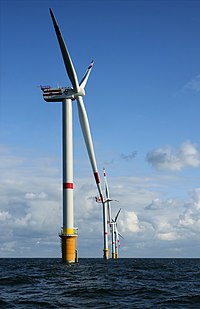
Photo from wikipedia
Accurate prediction of the time-dependent system dynamic responses of floating offshore wind turbines (FOWTs) under aero-hydro-coupled conditions is a challenge. This paper presents a numerical modeling tool using commercial computational… Click to show full abstract
Accurate prediction of the time-dependent system dynamic responses of floating offshore wind turbines (FOWTs) under aero-hydro-coupled conditions is a challenge. This paper presents a numerical modeling tool using commercial computational fluid dynamics software, STAR-CCM+(V12.02.010), to perform a fully coupled dynamic analysis of the DeepCwind semi-submersible floating platform with the National Renewable Engineering Lab (NREL) 5-MW baseline wind turbine model under combined wind–wave excitation environment conditions. Free-decay tests for rigid-body degrees of freedom (DOF) in still water and hydrodynamic tests for a regular wave are performed to validate the numerical model by inputting gross system parameters supported in the Offshore Code Comparison, Collaboration, Continued, with Correlations (OC5) project. A full-configuration FOWT simulation, with the simultaneous motion of the rotating blade due to 6-DOF platform dynamics, was performed. A relatively heavy load on the hub and blade was observed for the FOWT compared with the onshore wind turbine, leading to a 7.8% increase in the thrust curve; a 10% decrease in the power curve was also observed for the floating-type turbines, which could be attributed to the smaller project area and relative wind speed required for the rotor to receive wind power when the platform pitches. Finally, the tower-blade interference effects, blade-tip vortices, turbulent wakes, and shedding vortices in the fluid domain with relatively complex unsteady flow conditions were observed and investigated in detail.
Journal Title: Applied Sciences
Year Published: 2018
Link to full text (if available)
Share on Social Media: Sign Up to like & get
recommendations!